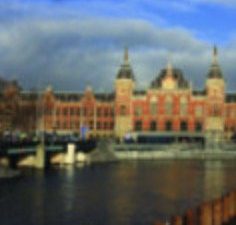Dutch Departures
November 1, 2017


Back in 1994, Eurostar was established as a high-speed train operator between London, Belgium and France via the Channel Tunnel. That’s the way it has stayed ever since – but now the rail firm, which is majority owned by France’s SNCF, is poised to exit its comfort zone and launch regular services to the Netherlands.
It is true that you can already book tickets from London to Holland on eurostar.com, but these are not direct services. They require a change at Brussels Midi and there is always the risk of missing connections.
The change of strategy has come with the arrival of new 900-seat Siemens e320 trainsets, which have the technical capability to operate into Holland. Eurostar’s original 750-seat Alstom e300 trains cannot do this unless they undergo modification, which was deemed to be uneconomical given their age.
Mind you, cynics would argue that Eurostar would have stayed in its comfort zone had it not been for Germany’s Deutsche Bahn (DB). In 2010, there was much excitement when DB announced it wanted to operate ICE through-trains (Germany’s high-speed version of France’s TGV) into London St Pancras from Holland, Belgium and Germany.
These plans never came to fruition – after years of battling with the Channel Tunnel authorities to have its ICEs certified, DB dropped its plans. But DB’s challenge did prompt incumbent Eurostar to up its game. Believing it would soon face competition, it ordered a fleet of swank Siemens trainsets and put expansion plans in motion.
Amsterdam and Rotterdam will be the first two Dutch cities to be served by Eurostar. Plans to call at Schiphol airport have been postponed. According to Nicholas Petrovic, chief executive of Eurostar, “With traveler demand for high-speed rail over plane ever-increasing, we are now gearing up to expand our reach to Amsterdam and Rotterdam. The exciting launch of our new direct service on this high-volume route [three million travelers fly between London and Amsterdam every year] represents a major growth opportunity for our business.”
Marjon Kaper, managing director of NS International, Dutch railway’s international marketing division, adds, “The preparations for the direct connection between Amsterdam and London with Eurostar are progressing well. All partners are working hard on this.”
Best-laid Plans
In truth, Eurostar had planned to launch its Amsterdam route by now, but it has been delayed more than once – and the latest plan sees it postponed yet again. Trains were expected to operate through to Amsterdam at the end of this year, but the latest news is that regular services will not happen until Easter 2018 at the earliest.
“Our plan is to have an e320 running between London, Amsterdam and Rotterdam by the end of the year for an inaugural service,” a Eurorail spokesperson says. “Then we will get ourselves used to operating on the new route and gearing up so that we are ready for the peak city-break Easter period.”
Mystery surrounds the arrangements that Eurostar will be making for immigration and security procedures. When the operator first started in 1994, customs and immigration checks were carried out on board, with passengers remaining in their seats while the officials came to them. The Alstom trains were even equipped with interview rooms and cells where suspect passengers could be detained. But now passengers must be checked before the train enters the Tunnel.
Frequent travelers through Amsterdam Centraal station know from experience it can get busy. There appears to be very little space to construct a separate terminal for UK-bound passengers’ immigration and security checks. Eurostar’s official line on the matter is: “We are working closely with the relevant authorities to advance these discussions and find the best solution to provide a fast and efficient service for our customers.”
Still, a photo recently uploaded to Twitter appeared to show a Eurostar terminal now under construction in a section of Amsterdam Centraal. The unofficial tweet was from an NS International staff member with the caption: “Rear track [platform] 15B on Amsterdam Centraal is old building demolished to make way for Eurostar terminal.”
Perhaps this is the cause of Eurostar’s Amsterdam-London route launch delay. Timings for the new service have yet to be confirmed but there will be two trains daily (weekend services may be reduced), the first departing London at about 8 AM to arrive in Amsterdam around 1 PM, some four hours later (allowing for the time change). The second service would depart London at about 5 PM, arriving at around 10 at night.
Departures out of Amsterdam would be roughly the same or earlier, but owing to the time difference, it is likely that the attraction will be greater for the Dutch market, given that it will take an hour less to London.
Will the new service attract business people? Much will depend on where your business takes you at either end, and how you plan the rest of your journey. Eurostar will score with those business people staying overnight or who may want to fly one-way and return by train, or vice-versa.
However people decide to use the new service, Eurostar will be offering a welcome alternative for travelers between London and Holland.
By Alex McWhirter




